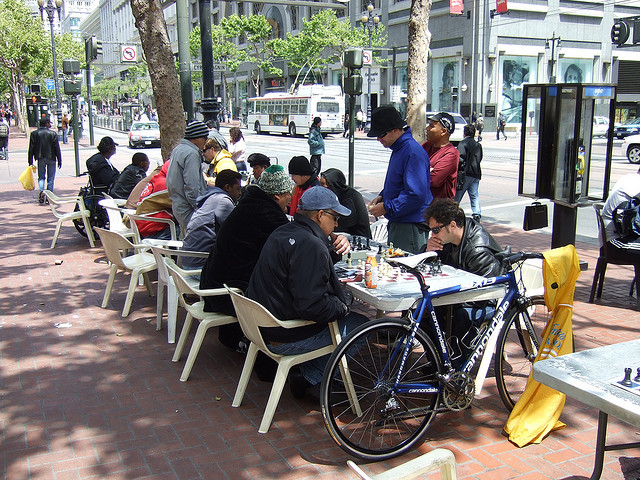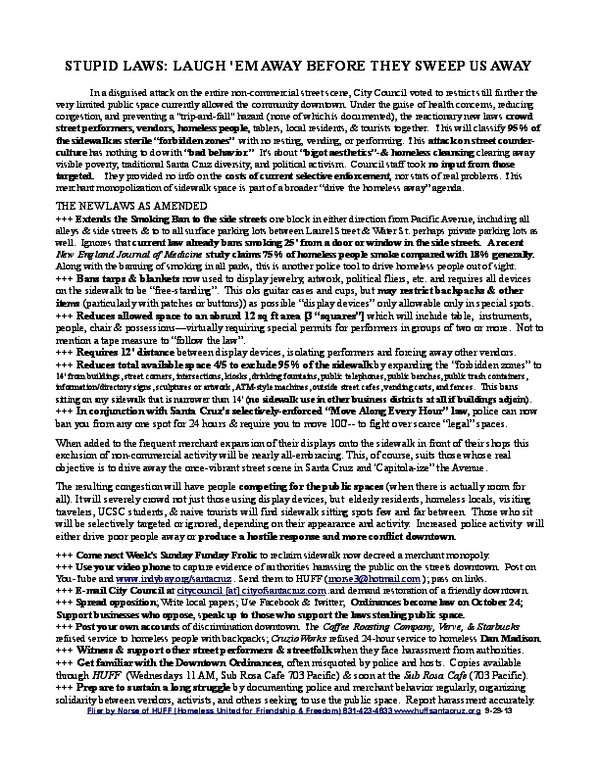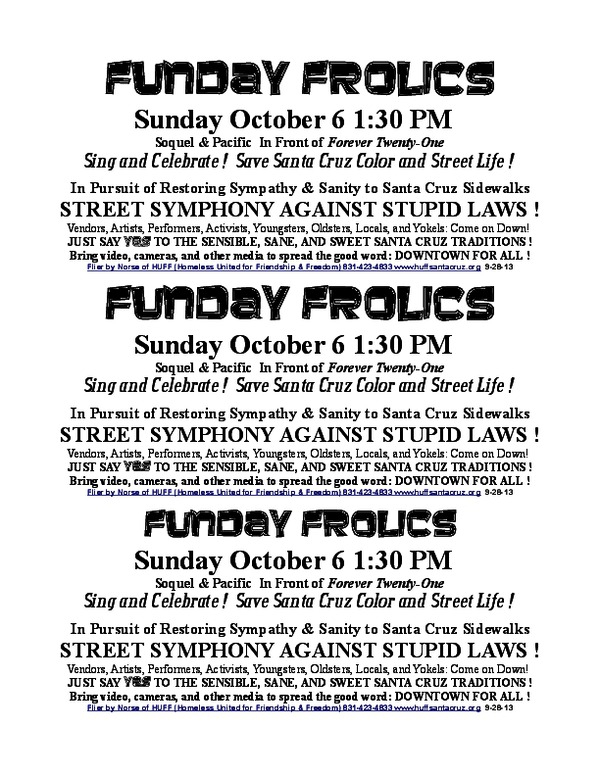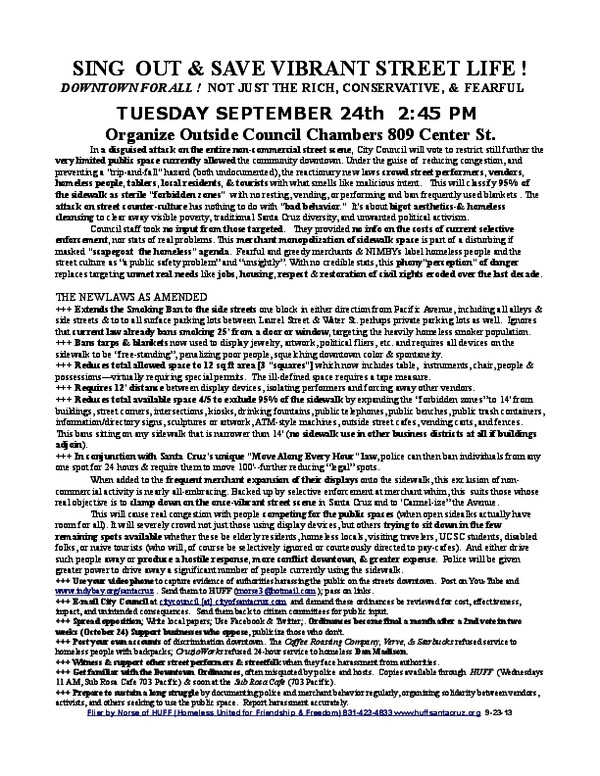NOTES BY NORSE: Eugene pioneered the Safe Parking/Camping Zones, in part because of pressure from homeless activists there two decades ago and recently from SLEEPS (Safe Legally Entitled Emergency Places to Sleep) as well as an active leftist and anarchist community.
Meanwhile Santa Cruz drops deeper into paranoia and anti-homeless hysteria with the Take Back Santa Cruz-inspired Needle-Free Zone homeless-aphobiacs. The repression contagion has spread—now street performers, vendors, artists, and political activists are under attack downtown.
New laws go into effect in Santa Cruz October 24th that will limit performance spaces to a 12′ square area and make traditional assembly and political activity illegal on 95% of the downtown sidewalks. These laws follow earlier ones that make it illegal to hold up peace signs on city medians (to outlaw panhandling there) and empower park officials to issue 1-day stay away orders prior to trial for “crimes in the park” like “trespass after dark” “smoking” and “sleeping after 11 PM”. An expansion of the Smoking Ban downtown targets homeless people (in a recent New England Journal of Medicine study, 17% of the general population smoke as distinguished from 75% of the homeless population).
Instead of opening existing bathrooms for 24-hour use, authorities are setting up a fenced off segregated portapotty as well as funding a $100 “Security” gate and fence around the Homeless (Lack of) Services Center. Activist Brent Adams has put forward a Sanctuary Camp plan disdained by the City Council majority. Instead Mayor Hillary Bryant’s band of bumbusters is backing a “Citizens Public Safety Task Force” which defines homeless survival activity like sleeping outside, camping in parks, and urinating and defecating in the woods as “criminal behavior”.
Though the City has announced multi-million dollar surplus in their budget this year, none of it will be going to fund campgrounds or restrooms or showers for the most needy. Eugene soars on, while Santa Cruz descends into a darker period.
A proposal that could allow Eugene to establish small homeless camps on yet-to-be-chosen sites was approved by the City Council on Monday night.
Councilors voted 6-2 to pass an ordinance recommended by City Manager Jon Ruiz that would allow the council to authorize more than one volunteer-run homeless camp of up to 15 people apiece — if the first camp works well.
Councilor Claire Syrett — who represents a ward that includes the Whiteaker, River Road and Santa Clara areas — said the proposal, which would allow camps to operate until next March, is not a cure for homelessness in Eugene.
But the camps will be better for some of the “hundreds of people” who have been sleeping for years in city parks and other public land, she said.
“It won’t fix all of the problems,” Syrett said. “It won’t fill all of the need, but it’s better than the status quo.”
Joining Syrett in voting for the proposal were councilors Alan Zelenka, Betty Taylor, George Brown, Chris Pryor and Greg Evans. Voting against were Councilors George Poling and Mike Clark.
Under the proposal, volunteers or nonprofit groups would manage the camps, and they would provide garbage service and portable toilets at no cost to the city. The council would control the number and location of camps, with the expectation that there would be little or no other costs to the city.
Potential sites could be located on city-owned parcels in commercial or industrial areas, or those offered by religious institutions, nonprofit groups or a business located on commercial or industrial-zoned property.
Until Monday, the council had been considering a proposal introduced by Zelenka to let the council authorize a single “rest stop” or overnight camp for up to 15 homeless people.
Under that proposal, the first camp would have been tried for 90 days to see how well it worked before other sites could be started. The proposal also would have required campers to pack up their belongings and leave the site each day.
But the concept was criticized at previous council meetings by homeless people and activists. Critics said a single site isn’t enough for the many homeless people in Eugene, and that requiring homeless people to pack up their belongings each day is impractical.
Ruiz, the city manager, on Friday made changes to a draft ordinance that could allow the establishment of more than one camp in the near future. He also added flexibility to the ordinance so that, depending on the site, campers wouldn’t necessarily have to pack up their belongings and leave each day.
Poling said he objected to the rest stop proposal being changed so that homeless people could stay on a site all day and night.
“That is no longer a rest stop,” he said. “That is a campground.”
Poling also faulted the proposal because the city would not be helping people to get out of homelessness.
“All we are doing is warehousing them and not working with them to end their homelessness,” he said.
Instead of establishing camps, Clark favored having the city act as a referral service to connect homeless people with property owners who would be willing to let homeless people camp on their property.
The camps proposed by Ruiz would be managed by “hosts” and the areas would be run according to site agreements between the site operators and the city. The camps could be terminated if the agreements are violated.
Previously, when city officials had begun working on the homeless camp idea at the direction of the council, they compiled a list of 19 possible sites that included undeveloped parkland in residential areas. That raised so much concern by nearby residents that the council eliminated potential sites in residential areas or those located close to a school.
On Monday night, several homeless advocates thanked Ruiz for developing his proposal.
Michael Carrigan, of the Community Alliance of Lane County, said people who want to help the homeless “are excited about this proposal and are ready to roll up their sleeves to make this work.”
Alley Valkyrie, a south Eugene resident who has been helping the homeless advocacy group known as SLEEPS, said she was “really stunned” by the city manager’s proposal.
“It’s a huge step in the right direction,” she said.
Valkyrie suggested that a camp be allowed on city land under the Ferry Street Bridge, where several campers have pitched tents. Another camp has been set up on city land at Broadway and Hilyard Street, which Valkyrie said is an excellent site.
The Rev. Dan Bryant, president of Opportunity Village Eugene, a newly formed housing area for homeless on Garfield Street, urged the council to approve the ordinance to get as many of the camps “up and running as quickly as possible, and we will work with you to help make that happen.”
You are here:
Home /
2013 /
May /
08 / CITY COUNCIL UNANIMOUSLY INSTRUCTS STAFF TO MOVE FORWARD WITH SLEEPING ORDINANCE
4.25.2013 Eugene, OR The Eugene City Council, which had dawdled unmercifully in coming to the table to discuss Safe Legally Entitled Emergency Places to SLEEP for those who are unhoused, arrived at the April 22 Council Work Session table with unprecedented determination to take immediate and purposeful action. The Councilors were brought to the table by Councilor Greg Evan’s leadership in calling for an official Council Work Session. Councilor Evans called the session following ongoing testimony from both housed and unhoused people affiliated with SLEEPS, CALC, Occupy, Interfaith Occupy, CLDC, Nightengale, ACT and other groups, stating that the testimony led him to believe that Eugene’s current policies were, at best, “counterintuitive”.
In a surprisingly bold move, in the early minutes of the session, Councilor Alan Zelenka made a motion to authorize city staff to draft an ordinance to designate temporary safe and legal place to sleep from 9PM to 7AM on non-park, city owned land. The motion passed unanimously, with Councilor George Poling absent. The Council also directed staff to call a special Work Session on the first date at which all Councilors can be present to review and approve an ordinance. Once approved, a Public Hearing will be held and the newly authorized “Rest Areas” can become a proud part of Eugene’s dramatically changing policies addressing issues surrounding those who are unhoused. The Council backed up their voiced support of finding creative, financially feasible and effective new solutions with a clear sense of enthusiasm and commitment….and action. At the next Session the Council will also seek to approve some of the four options proposed by city staff, most involving relationships between the city, religious, not for profit and private land owners. The Council indicated agreement that a whole continuum of small, partial and temporary solutions are needed to meet the emergency needs and buy time to find longer term answers.
The Rest Areas, as proposed by Councilor Zelenka, will be on several selected, specially designated, city owned non-park land parcels. They will offer a safe place to sleep from 9PM to 7AM, toilet access, garbage collection and lockers so that individuals can secure their items during the day, facilitating their ability to find work, housing, keep health appointments and conduct other personal business.
A major benefit of the Rest Areas is that they will draw people who now sleep downtown or in public parks away from those areas and into areas that are especially designed to meet the basic safety and sanitation needs of those who sleep in the areas. Insufficient bathrooms, especially at night, has been a major health hazard to all citizens in Eugene’s downtown and public parks and the new Rest Stops will improve the public health of all citizens. It establishes a new, more realistic and businesslike approach that will better meet the needs of the downtown and parks as well as the needs of those who need a place to sleep. The City’s long term failure to address the problem has put those needs unnecessarily in conflict.
Another major business benefit is that the Rest Areas should save a great deal of the current $300,000 per year the Eugene city government is spending to clean up deserted camps, often vacated as individuals flee under police orders. It will be far cheaper to take this preventive approach: placing toilets and garbage/recycling resources in the Rest Areas so that people can clean up after themselves. Not only has the City’s previous approach been a poor choice from a business perspectivie, it has posed health hazards for all and failed to meet the goal of chasing the unhoused out of Eugene.
Activists who have long been trying to persuade the Council to provide better solutions than in the past were impressed with the Mayor and Council’s obvious determination to do something substantive and to do it now. “It took a long time to encourage them to actually TALK about this really gnarly problem….but once they decided to take it on, they took it on with gusto. It us up to the rest of us, both housed and unhoused, to be certain that we give the Council the support they deserve for having the courage to admit that what we’re doing isn’t working and to start proving out better solutions”, said one activist.
Eugene council OKs small homeless camps operated by nonprofit groups outside neighborhoods
THE ASSOCIATED PRESS
September 24, 2013 – 4:36 pm EDT
EUGENE, Oregon — The Eugene City Council has given the go-ahead for homeless camps for no more than 15 people each on land owned by the city, churches or nonprofit groups in commercial or industrial areas.
The sites haven’t been designated. Activists have been demonstrating for months in favor of allowing homeless people to camp on city property.
The Council’s action Monday expands the proposal it had been considering, which would have been limited to one camp. Campers would have had to pack up their belongings and leave every day.
Instead, more than one camp will be allowed if the first one works, and some camps could allow residents to remain during the day.
City Manager Jon Ruiz said they would be managed by “hosts” and run according to site agreements between the site operators and the city.
Volunteers or nonprofit groups would provide garbage service and portable toilets at no cost to the city.
The Council would control the number and location of camps, with the expectation that there would be little or no other costs to the city.
The camps could be terminated if the agreements are violated, Ruiz said.
Alley Valkyrie, a south Eugene resident who has been speaking for the homeless advocacy group known as SLEEPS, said she was stunned.
“It’s a huge step in the right direction,” she said.
Demonstrations for homeless camps have been marked by arrests in recent months and a legal dispute over a free speech area outside the county courthouse.
Eugene Homeless Camp Broken Up In Free Speech Plaza
AP | Sept. 05, 2013 7:56 a.m. | Eugene, Oregon
A three-week-old camp-in protest at the Wayne Morse Free Speech Plaza in downtown Eugene was broken up Wednesday after Lane County commissioners enacted an emergency closure of the plaza.
The Eugene Register-Guard reports the Board of Commissioners voted 4-1 on the emergency closure. Protesters were given until Wednesday afternoon to clear out the camp. Four individuals later refused to leave and were cited for trespassing by Eugene police.
Officials say the closure will be used to clean all of the areas and work on further restrictions.
The group behind the makeshift campsite, Safe Legally Entitled Emergency Places to Sleep, or SLEEPS, is protesting the lack of legal camping areas for homeless people in Eugene.
___
Information from: The Register-Guard, http://www.registerguard.com
In this Sept. 5, 2013 photo, Mike Miller, of Bend, Ore., poses for a photo at a transient campsite, where he once spent several nights at during a year of living and camping outside. “This is survival for some people. I know it was for me,” Miller said. (AP Photo/The Bulletin, Joe Kline)
BEND, Ore. (AP) — Mike Miller had hit bottom.
Roughly eight years ago, he and a brother from San Jose, Calif., moved to a house in Bend for work. About two years later, Miller lost his job and took up drinking. His brother left for Nevada, and Miller was left alone.
Before he knew it, he was scouting secluded places to put up a tent to replace his lost home.
“I didn’t want to camp out,” Miller said. “It’s a part of my life I didn’t think I would go through. But, the things I was doing and the choices I made brought me here.”
Usually unseen or overlooked, homeless camps around Bend provide a temporary home for scores of homeless people. The camps may appear, be vacated and be re-established in a matter of days, according to Miller and others who’ve worked with or policed the homeless. Or they may quietly persist for months. They range from one person in one tent to several people in upward of 10 tents, according to Bend Police spokesman Lt. Chris Carney.
Nearly 2,200 people are experiencing homelessness in Central Oregon, according to the annual point-in-time count conducted in January by the Homeless Leadership Coalition. Of those 2,200 people, Miller feels most are down on their luck, just as he was.
But he knows that’s not everybody. Some choose to live that way, he said. “I was never threatened. But I know it does happen out there. I had one guy who watched my back as I watched his. It’s about surviving.”
Carney said the department deals with homeless camps all around Bend. For example, at least six camps lie within a five-mile radius of The Bethlehem Inn, a homeless shelter on U.S. Highway 97 in north Bend, according to managing director Chris Clouart. Most campers keep to themselves and hide from view, but sometimes events propel them into the forefront of public attention.
Saturday, Bend Police reported an attempted rape at a transient camp on Northeast Fourth Street. An alleged witness at the camp, Don Wichmann, performed a rare act and reported the incident to police. As a result, Jacob Schoenborn was held in Deschutes County jail on suspicion of first-degree rape, fourth-degree assault and two counts of first-degree sexual abuse.
“Most of the time, these people are camping because they want to be left alone,” said Carney. “Getting them to report incidents is always a tough thing to do.”
Crimes at these camps are not infrequent, Carney said. But they aren’t everything the camps are about. A fire in July that charred 4 acres in east Bend started with a homeless campfire. Two people — a mother and daughter — were cited in that incident. In addition, Carney said, stabbings and a shooting have occurred at homeless camps around the city within the past five years.
“It’s difficult to distinguish between the types of people who are out there,” he said. “Most of the people in these camps are people down on their luck — they can’t afford housing or something. But there are the others who choose that lifestyle and can sometimes cause problems.”
Residential camping in city limits is illegal, according to Bend affordable housing manager Jim Long. His department attempts to work with local nonprofits and businesses to find affordable housing for those whose income was diminished or demolished after the recession.
“Most people are one or two paychecks from tragedy anyway,” Long said. “If there’s 100 homeless people, there are 100 different stories. I don’t have rose-colored glasses — they aren’t all saints. But they aren’t all evil, either.”
He said the city attempts to move homeless camps as humanely as possible. Before calling the police, Long said, he would call the Central Oregon Veterans Organization or the Deschutes County Mental Health division in order to give the affected homeless a warning. If COVO and Deschutes County are unsuccessful, the police are called in.
“As a police department, we just go in there and tell them they have to camp outside of the city,” Carney said. “They typically pick up and move to a new spot. It’s about all we can do; we don’t have the time or resources to go out and force these people to move.”
Clouart said community calls to clean up homeless camps are routine following violent incidents like the one Saturday.
“It won’t solve anything,” Clouart said. “You’re just moving them from one place to another. To fix it, we need to become a society and a culture that doesn’t judge these people.”
Organizations around Bend attempt to keep judgment out of rehabilitation. The Shepherd’s House, a homeless men’s support shelter, offers a bed, food and shelter to applicants who are clean and sober. In emergency situations, it offers the same services to men for seven days. For those who need camping supplies, the shelter may provide them as well.
The Bethlehem Inn is open to men and women, offering the same “get back on your feet” services. COVO started a homeless outreach program, donating camping and survival supplies to ex-military men in need. “Feed the Hungry” hosts a breakfast and lunch at Bend’s Community Center every Sunday, and the center is getting ready to hand out survival gear to the “Keep Them Warm” program again.
Miller said he got so comfortable with camping that he was able to fashion a shower in his tent so he didn’t have to interact with people at camp showers. He said he notices others have taken up residence at the sites where he once camped.
“Some people just stay in that mindset of camping,” he said. “Some don’t want to stop doing that. I just realized that life wasn’t for me, and I was ready for a change.”
Miller, now 27 months free of alcohol, has lived at The Shepherd’s House for almost a year. He’s getting ready to move to Portland soon for an internship with a religious homeless-assistance organization and hopes to go to school later for addiction studies. Miller said he hopes to use his future education to help others in his former position, paying forward the help he received.
But no matter what, he won’t forget his time in the tent.
“You just learn how to blend in,” he said. “In fact, at one point, you get comfortable blending in. Once you get that comfortable, you don’t have a desire to stop blending in. And, by then, you’ve run out of options to get out.”
___
Information from: The Bulletin, http://www.bendbulletin.com
Copyright 2013 The Associated Press









